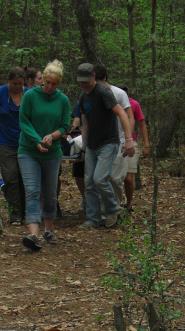Get Outdoors
"Shingles"
by Jan Hackett on 04/02/12
While doing some spring clean-up around the house I had a personal encounter of the painful kind. I reached into a pile of wood to grab a couple of old shingles. While walking and folding them to throw away I felt a sharp “sting” on my left thumb. As I threw them to the ground and looked at my thumb I saw the light brown Arachnid scurry away, I had been stung by a scorpion.
The pain was instantaneous with no obvious point of entry from the barb. I have used my Sawyer extractor for bee stings with great success and I headed to my first aid kit to conduct first hand research on scorpion stings. With no sign of entry it was difficult to know where to apply the suction which resulted in little or no benefit.
At that point I headed to get my lecture notes and double check the signs and symptoms along with treatment:
S/S
Grade I localized pain & numbness hurts more when taped on
Grade II pain & numbness spreads
Grade III Cranial or somatic nerve dysfunction
Cranial – jerky eye movement, trouble breathing & swallowing, slurred speech, airway problems
Somatic – restlessness, jerking & shaking of extremities
Grade IV – Both cranial & somatic nerve dysfunction
T/X
Grade I & II – Ice pack 30 minutes of each hour, oral pain killers
Grade III & IV – Same as above plus maintain airway
Antivenom is available but does not relieve pain only given if S/S are life threatening
I had a Grade I; localized pain & numbness hurts more when taped along with a little tingling in my lips. The numbness in my lips lasted about an hour and felt much like that last bit of Novocain wearing off. The thumb was still painful after four hours but I did not take any type of pain relief.
Scorpions are nocturnal feeders and seek shelter from the heat of the day under rocks, wood, shoes, clothing, sleeping bags and apparently shingles. The venom is a neurotoxin and is present in all 1752 species fortunately there are only 25 species known to have venom capable of killing humans.
The Hypothalamus
by Jan Hackett on 03/15/12
The hypothalamus is located in the brain just above the brain stem. One of it's most important functions is providing a link between the vervous system and the endocrine system. Another key function is the regulation of body temperature through automated responses such as vaso dilation/constriction and uncontrolled muscle flexion & estension i.e. shivering. The signals to regulate body temp comes from the skin and the spinal cord. These signals are transmitted with temperature changes of a fraction of one degree.
In the case of heavy exercise/heat illness the body is trying to cool itself through perspiration and vaso-dialation. This heat loss through evaporation and convective heat loss chills the skin tiggers the hypothalamus into thinking your cold causing the body to shiver generating additional heat. In the case of heat illness this becomes a serious problem
Leave No Trace
by Jan Hackett on 03/08/12
As you prepare for your 2012 outdoor activities I encourage you to incorparate Leave No Trace ethics in your planning. The idea of minimizing impact to the land was concieved in the 1960's by the U.S. Forest Service. As public land use increased the Forest Service along with the Bureau of Land Management and the National Park Service developed early wilderness princilpals.
The Forest Service introduced it's formal "No Trace" in the mid 1980's and it's success led to the combined efforts of the agencies listed above to develop a pamphlet titled "Leave No Trace Land Ethics".
In 1993 an outdoor recreation summit was conviened that included federal land management agencies, outdoor industry trade associations, NOLS, various non-profit organizations and outdoor manufactures. The result of this gathering was the forming of an independant 501-3-c non-profit "Leave No Trace Inc."
Known today as the Leave No Trace Center for Outdoor Ethics it has developed and expanded LNT education and training since 1994. So as you plan your outdoor activities for 2012 and beyond please remember the 7 principals of LNT:
- Plan ahead
- Camp & travel on durable surfaces
- Dispose of waste properly
- Leave what you find
- Minimize the impact of fire
- Respect wildlife
- Be considerate of others
Cold Exposure Illness
by Jan Hackett on 01/16/12
Students often wonder about paradoxial undressing during hypothermia i.e. ripping your clothes off even though your core is cold. This occurs about 25-50% of the time in severe cases of hypothernia. There are two explanations that are common. One is the drop in core body temperature causes the hypothalamus simply to malfunction tricking you into thinking you are warm. The second is that the blood vessels become fatigued from the constant consriction/dilation to regulate body temp. The vessels relax casusing warm blood to flow from the core to the skin fooling the brain into thinking your overheated. Which ever is actual reason the result is the same, off come the clothes!

